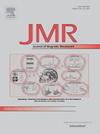Dipolar-order-based broadband adiabatic inversion as cross- polarization alternative in solid state Wideline NMR
IF 1.9
3区 化学
Q3 BIOCHEMICAL RESEARCH METHODS
引用次数: 0
Abstract
Solid-state nuclear magnetic resonance (NMR) can shed light on atomic-level arrangements for most elements in the Periodic Table. This ability hinges on the possibility to overcome NMR's low sensitivity, particularly when dealing with unreceptive nuclei yielding ultra-wideline (>500 kHz) patterns from powdered samples. Herein, we present an experiment capable of enhancing the signals of such static samples, by transferring dipolar order from surrounding, highly polarized protons. The experiment, which we dub Dipolar-Order-based BRoadband Adiabatic INversion Cross-Polarization (DOBRAIN-CP), utilizes a Freeman-Kupče broadband inversion WURST pulse to perform CP over the wideline spectrum of the low receptivity species, while matching the low frequencies associated to 1H![]() 1H dipolar fields. We present analytical and numerical analyses of the spin-dynamics of DOBRAIN-CP for spin-½ nuclei, as well as for quadrupolar spins. Experimental results are also presented for spin-½, integer and half-integer quadrupolar spins; these show that although DOBRAIN-CP delivers broadband excitation and sensitivity enhancement compared to direct excitations, it does not exceed the sensitivity enhancement of the BRAIN-CP variant based on Hartmann-Hahn matching. The power requirements for DOBRAIN-CP are extremely low, yet long dipolar-order lifetimes T1D are needed to support the DOBRAIN-CP build-up times.
1H dipolar fields. We present analytical and numerical analyses of the spin-dynamics of DOBRAIN-CP for spin-½ nuclei, as well as for quadrupolar spins. Experimental results are also presented for spin-½, integer and half-integer quadrupolar spins; these show that although DOBRAIN-CP delivers broadband excitation and sensitivity enhancement compared to direct excitations, it does not exceed the sensitivity enhancement of the BRAIN-CP variant based on Hartmann-Hahn matching. The power requirements for DOBRAIN-CP are extremely low, yet long dipolar-order lifetimes T1D are needed to support the DOBRAIN-CP build-up times.

基于偶极序的宽带绝热反演作为固态宽线核磁共振交叉极化替代方法
固体核磁共振(NMR)可以揭示元素周期表中大多数元素的原子水平排列。这种能力取决于克服核磁共振低灵敏度的可能性,特别是在处理从粉末样品中产生超宽线(>500 kHz)模式的非接受核时。在这里,我们提出了一个能够通过从周围的高极化质子转移偶极序来增强这种静态样品信号的实验。该实验被称为基于偶极序的宽带绝热反转交叉极化(DOBRAIN-CP),利用freeman - kupe宽带反转WURST脉冲在低接受度的宽谱上执行CP,同时匹配与1H1H偶极场相关的低频。我们对自旋为1 / 2的DOBRAIN-CP原子核以及四极自旋的自旋动力学进行了分析和数值分析。还给出了自旋1 / 2、整数和半整数四极自旋的实验结果;这些结果表明,尽管与直接激励相比,DOBRAIN-CP提供了宽带激励和灵敏度增强,但其灵敏度增强并不超过基于Hartmann-Hahn匹配的BRAIN-CP变体。DOBRAIN-CP的功率要求极低,但需要长偶极序寿命T1D来支持DOBRAIN-CP的构建时间。
本文章由计算机程序翻译,如有差异,请以英文原文为准。
求助全文
约1分钟内获得全文
求助全文
来源期刊
CiteScore
3.80
自引率
13.60%
发文量
150
审稿时长
69 days
期刊介绍:
The Journal of Magnetic Resonance presents original technical and scientific papers in all aspects of magnetic resonance, including nuclear magnetic resonance spectroscopy (NMR) of solids and liquids, electron spin/paramagnetic resonance (EPR), in vivo magnetic resonance imaging (MRI) and spectroscopy (MRS), nuclear quadrupole resonance (NQR) and magnetic resonance phenomena at nearly zero fields or in combination with optics. The Journal''s main aims include deepening the physical principles underlying all these spectroscopies, publishing significant theoretical and experimental results leading to spectral and spatial progress in these areas, and opening new MR-based applications in chemistry, biology and medicine. The Journal also seeks descriptions of novel apparatuses, new experimental protocols, and new procedures of data analysis and interpretation - including computational and quantum-mechanical methods - capable of advancing MR spectroscopy and imaging.

 求助内容:
求助内容: 应助结果提醒方式:
应助结果提醒方式:


